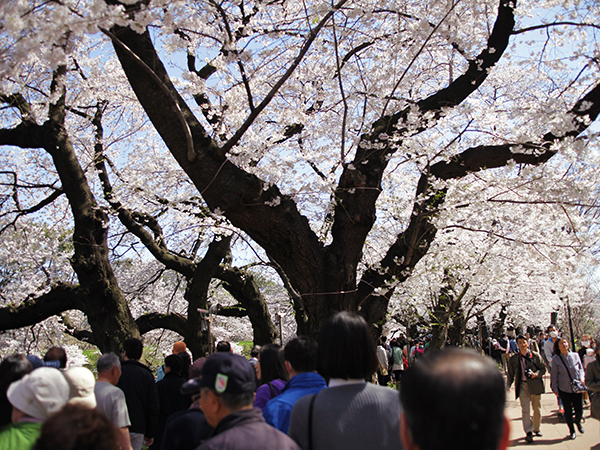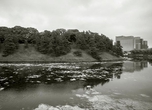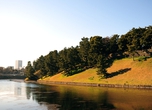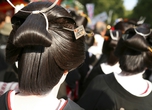The cherry blossoms of Edo
In part 4 of our 'Transcreating Tokyo' series, Takeo Funabiki surveys the sakura

Posted: Tue Apr 01 2014

It is perhaps only in Japan that the nightly TV news can open with a story declaring the start of the cherry blossom season before moving on to Putin's declaration that Russia has annexed Crimea. This purpose of this column, however, is not to lament Japan’s inward-looking tendencies – here, I take the position that Tokyo's cherry blossoms are in fact very worthy of discussion.
There are good reasons for why the northward march of the ‘cherry blossom front’ is a topic of such intense interest. One is the fact that unlike hibiscus or skunk cabbage, cherry trees bloom everywhere in Japan. True, camellias also bloom in every corner of this country, but those flowers are far less popular and also do not burst open all at once along a clearly noticeable ‘front line’ like the sakura do. This relates to another factor, namely that the Japanese island chain stretches over a considerable distance from north to south – the archipelago is almost as long as the distance between Norway’s Oslo and Algeria. The ‘front’ begins its charge in Okinawa in February and then marches northward until it reaches Hokkaido around the Golden Week holidays in early May, ensuring that the pink flowers stay in the news over an extended period of time.

Where, then, should you view the blossoms in Tokyo? To answer like a travel guide, anywhere is fine. When I was young, we would hop onto the Inokashira train line from Shibuya and sit by the windows admiring trees blossoming along the tracks. Of course, as described in the first column of this series, the Chidorigafuchi area by the Imperial Palace is excellent, while Kita-ku’s Asukayama Park and the banks of the Sumida River have been reliable spots since the Edo era. Above all, cherry trees can be found in public spaces like schoolyards and parks as well as along city streets and river banks, but rarely in private gardens. Let’s examine why this is the case.
Blooming just before the sakura, plum blossoms actually used to be the flower of choice from the Nara period (710-794) and well into the Heian period (794-1185), as these purple and white beauties were held in high esteem in Chinese culture. However, by the early Kamakura period (1185-1333), cherry blossoms began to trump plums in the popular imagination, particularly after the poet Saigyo composed a verse declaring his wish to die under a cherry tree in spring, and by the Edo period, sakura had completely eclipsed the ume. On a personal level, I find it difficult to simply discard the plum, especially since cherry blossoms are very much lacking in fragrance. Nonetheless, the plum also has many drawbacks, including its slight frame that makes it suitable for a garden but lacks power in a grove. It makes an even worse street tree, and although cherry trees hardly provide much shade either, at least their spectacular flowers present a grand sight along rivers or major streets. However, the image we have of cherry trees today mostly relates to the Somei-Yoshino kind, an improved variety originating in the early Meiji era, so cherry trees before that were slightly different specimens. The Somei-Yoshino was a response to the Japanese ideal of marvellously blooming sakura, as exemplified by earlier varieties like the Yaezakura and Yamazakura.
Moving on, the reason why the cherry blossoms became such an irresistible attraction, always drawing huge crowds, has to do with the overarching theme of this column series, namely that Edo/Tokyo is an ‘artificial’ city, constantly moulded by human hands. As continuous rounds of planning expanded the city, disastrous fires led to the creation of public spaces in the form of firebreak zones. Like today's parks, those sites eventually became gathering places where merchants peddled their wares. The Shogunate then moved to provide entertainment for the rising masses in the form of cherry trees, under which hanami parties could be held. Although personal feelings were also involved – Shogun Yoshimune was an avid admirer of sakura – the citizens of Edo quickly took the cherry blossoms to heart, developing an appreciation for the pompous aesthetic of urban sakura, and a number of famous viewing spots soon became part of the city’s geography.
Although I have not studied this in any great detail yet, I hypothesise that the daimyo (feudal lords) stationed in Edo also acquired a taste for the capital’s hanami culture, and came to plant cherry trees around their castles, along banks and in other public spaces in the provinces, thus creating many of the famed sakura vistas that continue to be appreciated all over Japan. In addition, as cherry trees began to be planted in schoolyards nationwide along with the establishment of the system of universal education after the Meiji Restoration, the love of sakura spread far beyond its original home in Edo. The breeding and improvement of the Somei-Yoshino tree, mentioned above, is likely to have been proposed as a new objective for such public works as well. Over the course of a thousand years, the praised plum trees in the gardens of the Heian nobility were overtaken by the wild cherry blossoms of places like Nara’s Mount Yoshino – a change in people’s sense of beauty that eventually gave birth to Edo’s peculiar urban aesthetic. This development, which can be described as a cherry blossom-centred Japanese unification movement, continues even today.
Takeo Funabiki
Cultural anthropologist
1948, born in Tokyo
1972, BA, University of Tokyo, Faculty of Liberal Arts
1982, PhD in anthropology, Cambridge University, Graduate School of Social Anthropology
1983, University of Tokyo, College of Arts and Sciences, lecturer
1994, Professor
1996, University of Tokyo, Graduate School of Arts and Sciences, professor
2012, retired from the Graduate School, Professor Emeritus
Field work conducted in Hawaii, Tahiti, Japan (Yamagata Shonaiheiya), East Asia (China, Korea) and Melanesia/Polynesia (Vanuatu, Papua New Guinea). Professional interests include 1) mechanism of mutual interference of human culture and nature, 2) the representations of ritual and theatre, and 3) changes in culture and society that occur during the course of modernisation.
Tweets
- About Us |
- Work for Time Out |
- Send us info |
- Advertising |
- Mobile edition |
- Terms & Conditions |
- Privacy policy |
- Contact Us
Copyright © 2014 Time Out Tokyo














Add your comment